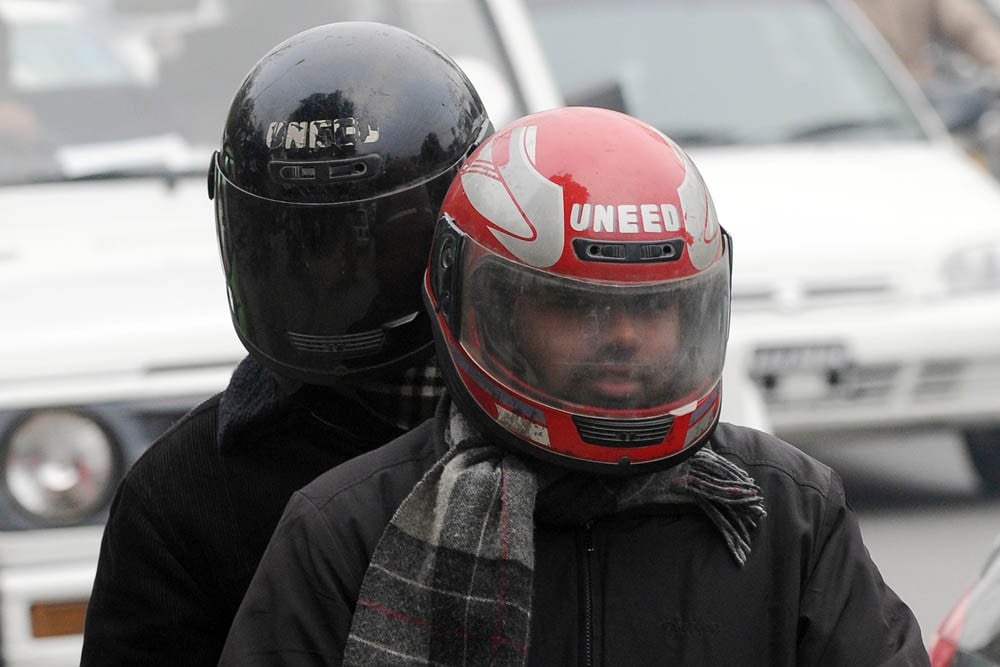
The common public shall take time before it can be conditioned to using crash helmet as a routine

All recent measures taken by the city district government to make crash helmets mandatory for motorcyclists seem to have come to naught, as the common biker continues to ply on the roads without bothering to use headgear.
According to an unofficial estimate, 92 percent motorcyclists do not sport a helmet. What’s more, they go around with impunity. What does it show? That the government failed to ensure implementation, or perhaps, that the policy is flawed.
All told, the motorbike riding bylaw was imposed in the year 2005. Interestingly, even though the traffic police unleashed massive drives, imposing heavy fine on the violators, they could not help to create a culture of wearing helmet. And, the situation remains the same till date.
Insiders at the office of the Chief Traffic Officer swear by the fact that Lahore has as many as three million motorcycles plying on the roads, and only 10 percent of these uses helmet.
"As summers set in, the biker who would otherwise use helmet takes it off as he feels suffocated," says an official, requesting anonymity.
However, Section 69-A of the Motor Vehicle Ordinance, 1965 and Section 239-A of the Motor Vehicle Rules, 1969 offer no weather-related concession. "The law clearly states that a biker is obligated to wear helmet, come rain or shine!" the traffic official declares.
Jamil Farooq, a student at Punjab University, puts it in the following words, "When the temperature begins to soar, it becomes hard for you to wear a helmet. Such is the material [thermopore] that it is made of."
He urges the government to engage companies that manufacture weather-friendly helmets.
In an undesirable development, tangible damage is due to the enforcement of the said law at the hands of the Mujahid Squad, Elite Force, traffic wardens and other cops who are found riding their bikes without sporting a headgear, especially during their work hours. They have no fear of being challaned so they can get away with it.
On the other hand, the local market is teeming with low-quality helmets. As these are sold at fairly cheaper rates -- ranging between Rs300-700 -- the people prefer to pick them off these low-end markets. Good quality helmets are priced at Rs2,000-6,000. As no one bothers, even a safety helmet, the kind worn by construction workers, is believed to do the needful.
A crash helmet is meant to save the bike rider from any serious head injury. Helmets made of substandard material cannot serve the purpose. It has often been observed that an accident proved fatal even though the biker was wearing the helmet, because its material was of poor quality.
Recently, there has been a public uproar on the imposition of fines on helmet-less bikers which is largely seen as a money minting ploy that has impeded the sensitisation drive and a cultivation of the helmet wearing culture. Reports have it that the traffic department collected over Rs510 million from the helmet challans alone in the year 2015.
Talking exclusively to TNS, Chief Traffic Officer (CTO) Tayyab Hafeez Cheema admits that the cops are not above the law. "They may not be a good example for the public as most of them aren’t found sporting helmet while riding the bike. But every policeman, irrespective of his department or designation, is strictly ordered to wear helmet. Otherwise the law will take its course."
It is obvious that the common public shall take time before it is conditioned to wearing helmet as a routine. "We issued a fine of Rs314,000 and distributed around 7,000 helmets for free, in a bid to sensitise the people," Cheema insists. "Our primary goal is to increase the helmet enforceability by using all possible means."
Throwing light on the department’s new, multi-pronged strategy to do the needful, Cheema says that as part of the plan, the traffic police are particularly aiming at women. "The idea is to educate them so that they can push the men in their family to wear helmets if they care for their safety."
In a recent meeting, the Traffic Management Committee decided to regulate the prices of helmet so that its affordability can be ensured.
The fresh campaign also entails setting up 100 points where quality helmets are made available on a set price so that the profiteers can be discouraged.
Another right step in this direction is the coming into effect of a law that shall bind the sellers to offer helmets alongside the bikes.
As per Section 89-A of Motor Vehicle Ordinance, 1965 no person shall drive or ride the pillion seat of a motorcycle except when he is wearing a crash helmet (crash helmet means a helmet made of such material and meeting such other requirements as may be prescribed). Those who defy this rule can be fined up to Rs200 under the Highway Traffic Code 2000.
When the law was challenged a few years back, the then LHC chief justice Iftikhar Hussain said that the court had not given a concession to the women bikers. The court ordered not to detain the violator nor impound the motorcycle under Section 115 of the MVO in case the rider is found without a helmet.
A senior official at Rescue 1122, Jam Sajjad Hussain confirms that more than 70 percent deaths in motorbike accidents take place because the riders were not wearing headgear. A majority of these happen to be young boys.
He agrees with the fact that if the level of performance, monitoring and evaluation of the department matches that of the Motorway Police, road safety sense and the helmet law shall easily become effective.